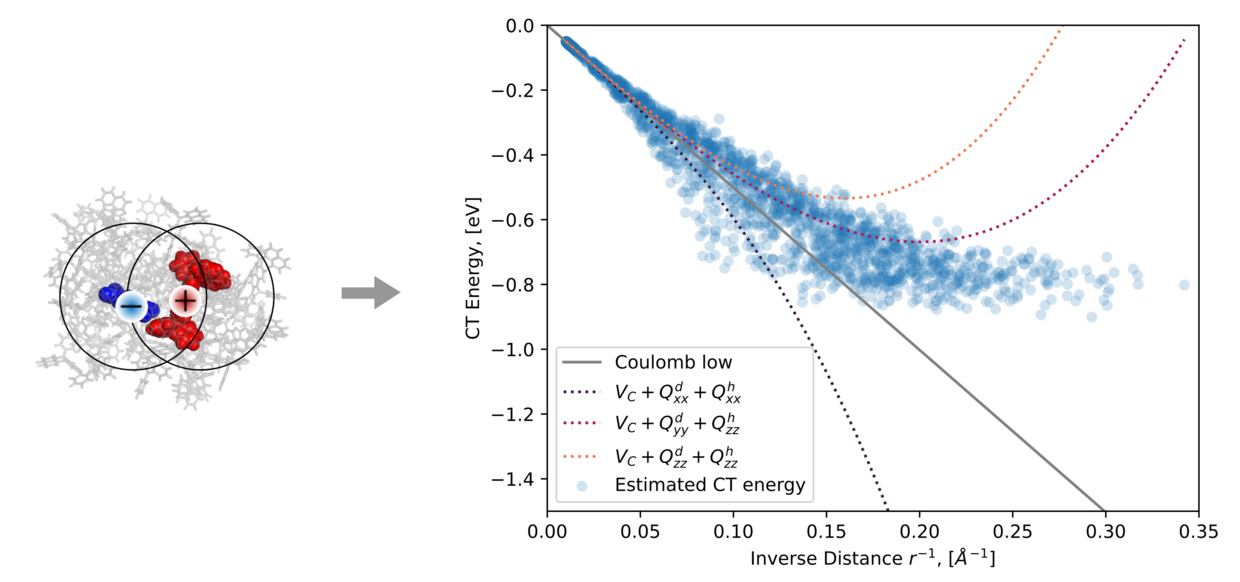Introduction
The evolution of organic semiconductors (OS) has revolutionized the electronics industry, from organic light-emitting diodes (OLEDs) to organic solar cells. Despite their advantages like a low cost, flexibility, sustainability, OS materials face significant challenges due to their inherently low conductivity. To address this, conductivity doping - adding specific molecules to enhance electrical conductivity - is used. While the doped layers themselves do not emit light, they enable efficient charge injection and extraction in OLED devices, ensuring optimal performance in the active layers where light is generated. Traditionally, designing new dopants relies on a trial-and-error approach, which often overlooks possible design strategies. In this project, we employ a physical multiscale model that spans atomic to material levels, uncovering new and previously overlooked pathways for designing high-performance doped layers.
| Principal investigator: | Prof. Dr. Wolfgang Wenzel |
| Project manager: | Dr. Philipp Dullinger |
| Researcher: | Dr. Artem Fediai |
| Date published: | February 2025 |
| HPC platform used: | HoreKa |
| Affiliation: | Karlsruhe Institute of Technology (KIT) |
| Institute: | Institute of Nanotechnology |
| Research field: | Physics |
| Project ID: | DOLED |
Project description
Organic semiconductors have garnered significant attention for their potential in lightweight, flexible electronics, but their intrinsically low conductivity presents a big challenge when it goes about the injection to the active device levels. This project addresses this limitation employing a multiscale workflow to design and optimize doped organic semiconductors.
Methods
The multi-scale workflow begins with the parametrization of individual molecules, capturing their electronic properties through quantum mechanical calculations. These molecules are then deposited into thin-film morphologies using a Monte Carlo-based protocol that mimics physical vapor deposition.[1] This step ensures generating realistic morphologies, embedding every molecule into the material so that the molecule is exposed to the same environment as in the real materials. Following morphology generation, quantum chemistry embedding method “QuantumPatch”, [2] is used to compute key properties, including ionization rates, Coulomb binding energies, and the impact of molecular orientations on charge transfer. This method explicitly treats embedded molecules along with their neighboring molecules using various quantum-mechanical approaches, such as DFT and GW, involving thousands of single-point DFT simulations. This approach provides highly accurate results but requires substantial computational resources. The outputs are then integrated into kinetic Monte Carlo simulations, which calculate charge mobility and doping efficiency across various host-dopant combinations. This process effectively maps the molecular structure (atomic level) to material performance (macroscopic level).
Results
Current results based on the multiscale simulations of several doped organic materials, have uncovered a "short-range overscreening effect" [3] where the host-dopant Coulomb interaction is considerably weaker than expected. This phenomenon significantly impacts the conductivity of doped organic semiconductors. We demonstrate that by carefully engineering the molecular structure of dopants, it is possible to achieve a significant reduction in the electrostatic forces that typically trap charge carriers. This effect paves the way to creating organic materials with conductivity improvements of up to 100 times compared to previous designs.
Outlook. Future work is planned to explore an established multiscale workflow for understanding and optimizing organic semiconductors by using dopants not only as conductivity enhancers but also as agents to investigate fundamental electronic properties. These properties, such as ionization potential (IP), electron affinity (EA), and Coulomb interaction energy (VC), are critical to the performance of organic devices like OLEDs, organic solar cells, and organic transistors. Since both simulations and experimental methods provide access to quantities such as ionized dopant fraction and conductivity, which are closely related to IP, EA, and VC, we will investigate the potential to indirectly determine these properties by measuring or simulating macroscopic properties like conductivity and ionized dopant fraction.
References
Neumann T, Danilov D, Lennartz C, Wenzel W. Modeling disordered morphologies in organic semiconductors. J Comput Chem. 2013 Dec 5;34(31):2716–25.
Armleder J, Strunk T, Symalla F, Friederich P, Enrique Olivares Peña J, Neumann T, et al. Computing charging and polarization energies of small organic molecules embedded into amorphous materials with quantum accuracy. J Chem Theory Comput. 2021;17(6).
Armleder J, Neumann T, Symalla F, Strunk T, Pena J, Wenzel W, et al. Controlling doping efficiency in organic semiconductors by tuning short-range overscreening. Nat Commun. 2023 Mar 13;14(1).

